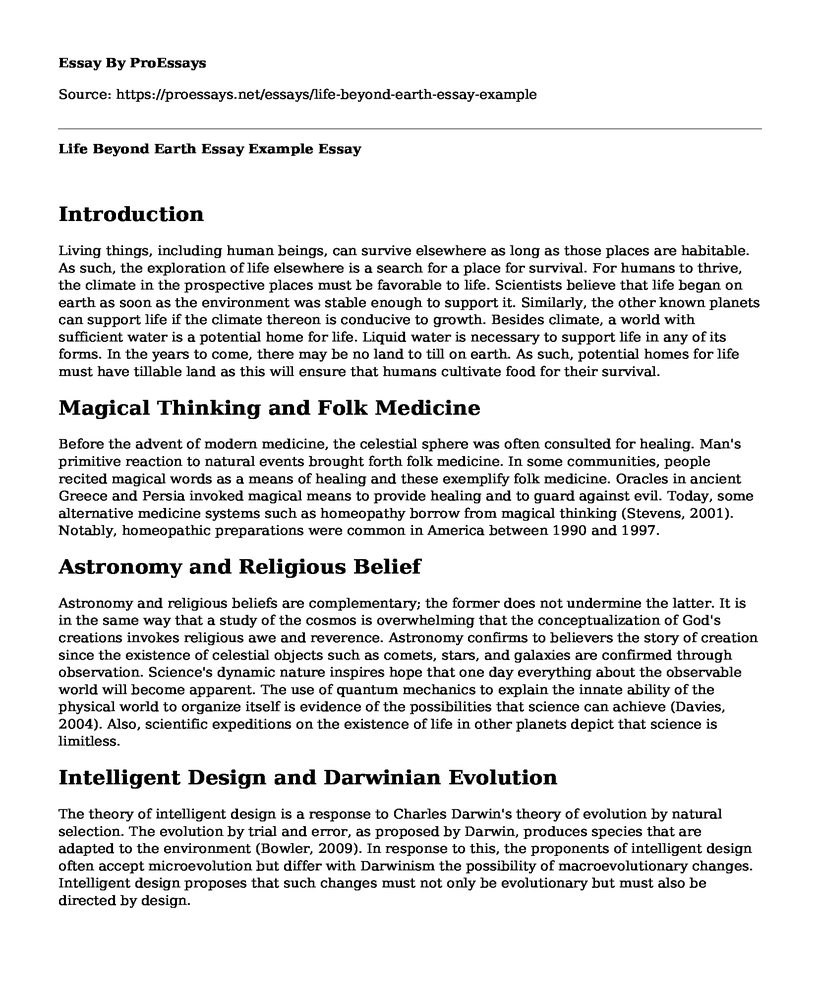Introduction
Living things, including human beings, can survive elsewhere as long as those places are habitable. As such, the exploration of life elsewhere is a search for a place for survival. For humans to thrive, the climate in the prospective places must be favorable to life. Scientists believe that life began on earth as soon as the environment was stable enough to support it. Similarly, the other known planets can support life if the climate thereon is conducive to growth. Besides climate, a world with sufficient water is a potential home for life. Liquid water is necessary to support life in any of its forms. In the years to come, there may be no land to till on earth. As such, potential homes for life must have tillable land as this will ensure that humans cultivate food for their survival.
Magical Thinking and Folk Medicine
Before the advent of modern medicine, the celestial sphere was often consulted for healing. Man's primitive reaction to natural events brought forth folk medicine. In some communities, people recited magical words as a means of healing and these exemplify folk medicine. Oracles in ancient Greece and Persia invoked magical means to provide healing and to guard against evil. Today, some alternative medicine systems such as homeopathy borrow from magical thinking (Stevens, 2001). Notably, homeopathic preparations were common in America between 1990 and 1997.
Astronomy and Religious Belief
Astronomy and religious beliefs are complementary; the former does not undermine the latter. It is in the same way that a study of the cosmos is overwhelming that the conceptualization of God's creations invokes religious awe and reverence. Astronomy confirms to believers the story of creation since the existence of celestial objects such as comets, stars, and galaxies are confirmed through observation. Science's dynamic nature inspires hope that one day everything about the observable world will become apparent. The use of quantum mechanics to explain the innate ability of the physical world to organize itself is evidence of the possibilities that science can achieve (Davies, 2004). Also, scientific expeditions on the existence of life in other planets depict that science is limitless.
Intelligent Design and Darwinian Evolution
The theory of intelligent design is a response to Charles Darwin's theory of evolution by natural selection. The evolution by trial and error, as proposed by Darwin, produces species that are adapted to the environment (Bowler, 2009). In response to this, the proponents of intelligent design often accept microevolution but differ with Darwinism the possibility of macroevolutionary changes. Intelligent design proposes that such changes must not only be evolutionary but must also be directed by design.
Life-Threatening Danger
The three factors of subjective effects are mystical, depersonalization, and hyperalertness. Noyes defines depersonalization as being in a trancelike state. It is characterized by feelings of unreality and separation from the body (Noyes Jr & Slymen, 1979). A depersonalized patient feels like a stranger to themselves since the world appears foreign and dreamlike. For instance, they can view their body from a vantage point. Mystical consciousness is exemplified by feelings of great comprehension and the appearance of vivid images. In this state, a person may, for instance, conduct a review of their life even in their state of unconsciousness. Hyperalertness is characterized by very vivid thoughts extremely sharp vision and hearing. Examples of hyperalertness include seeing spiritual entities and hearing unusual sounds.
The Afterlife
Ancient civilizations had different beliefs about the afterlife. The Mesopotamians believed that after one dies, the immortal part of their body remains as a spirit and eventually travels to the underworld. Upon its arrival, the immortal being was judged by deities and given a place in the afterlife. Some Native Americans believed in an afterlife where there was a lot of buffalo to hunt. The Pueblo Indians, on the other hand, reunited with the dead people whom they knew in their lifetime.
References
Bowler, P. J. (2009). Monkey trials and gorilla sermons: Evolution and Christianity from Darwin to intelligent design. Harvard University Press.
Davies, P. (2004). Cosmic Blueprint: New Discoveries In Natures Ability To Order Universe. Templeton Foundation Press.
Noyes Jr, R., & Slymen, D. J. (1979). The subjective response to life-threatening danger. OMEGA-Journal of Death and Dying, 9(4), 313-321.
Stevens, P. (2001). Magical thinking in complementary and alternative medicine. Skeptical Inquirer, 25(6), 32-37.
Cite this page
Life Beyond Earth Essay Example. (2022, Dec 14). Retrieved from https://proessays.net/essays/life-beyond-earth-essay-example
If you are the original author of this essay and no longer wish to have it published on the ProEssays website, please click below to request its removal:
- Whether My Sense of Smell Affect My Sense of Taste? - Essay Sample
- Surfactants, Magnetic Field, Cleaning up Oil on Birds' Feathers
- Critical Essay on What is Islam? The Importance of Being Islamic by Shahab Ahmed
- The Race for Theory - Essay Sample
- Essay Example on Exploring Religion and Spirituality: Reasons to Lead a Spiritual Life
- Paper Example on Identifying Animals With Animal Microchips: A Guide
- Spirituality Reflective Paper Example







